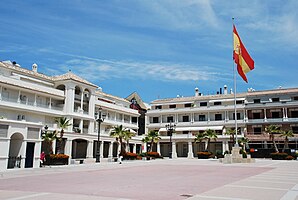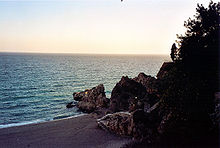Nerja
| Nerja municipality | ||
|---|---|---|
 Plaza de España
|
||
| coat of arms | Map of Spain | |

|
|
|
| Basic data | ||
| Autonomous Community : | Andalusia | |
| Province : | Málaga | |
| Comarca : | Axarquía - Costa del Sol | |
| Coordinates | 36 ° 45 ′ N , 3 ° 53 ′ W | |
| Height : | 26 msnm | |
| Area : | 84.9 km² | |
| Residents : | 21.091 (Jan. 1, 2019) | |
| Population density : | 248.42 inhabitants / km² | |
| Postal code : | 29780 | |
| Municipality number ( INE ): | 29075 | |
| Nearest airport : | Málaga ( Aeropuerto de Málaga , 60 km ) | |
| administration | ||
| Official language : | Castilian | |
| Mayor : | José Alberto Armijo ( PP ) | |
| Website : | www.nerja.es | |
| Location of the municipality | ||
Málaga Province
|
||
Nerja [ ˈneɾxa ] is a municipality (Spanish: municipio ) in Spain . Nerja is located in Andalusia , in the province of Málaga on the Costa del Sol, about 50 kilometers east of Málaga , in the Axarquía . The population is around 22,000, with several thousand tourists arriving in summer . The municipality of Nerja includes the city of Nerja and the village of Maro, which is about five kilometers away.
geography
Location and geology
Nerja is located on the western Mediterranean on the Costa del Sol at the foot of the Sierra de Almijara . To the north-east of the village are the mountains Pico del Cielo (1,508 m), the Cerro Cabeza del Caballo (1,188 m) and on the northern municipal boundary the Tajo del Almendrón (1,514 m) and the Torre del Almendrón (1,335 m). The Rio Chíllar flows through the municipality and flows into the Mediterranean Sea west of Nerja.
Beaches and coasts
Nerja has a coastline of 14 kilometers from east to west. The names of the beaches are el Playazo, el Chucho, la Torrecilla, el Salón, la Caletilla, Calahonda, el Chorrillo, Carabeo, Carabeillo and Burriana. El Playazo impresses with an environment that has not yet fallen victim to the consequences of urbanization on the coast of Malaga. The beaches of Burriana and la Torrecilla are barrier-free. The names of the cliffs are la Cala "Barranco de Maro", la Caleta, el acantilado (steep coast) de Maro, la Torre de Maro, el Molino de papel, las Alberquillas, "Cala del Pino" and Cala El cañuelo.
history
In the caves about five kilometers from the city of Nerja, north of Maro, evidence of human settlement from the Paleolithic was found.
Evidence of the Roman settlement Detunda has been found in the village of Maro, four kilometers east of the city of Nerja .
The Moors built the first buildings a little further inland than the city is today.
The first written references to the name Nerja come from the historian Almacarri de Tremecen and the Arab poet and geographer Ibn Sadí around the year 917, with the place name Nerja, Naricha, Narixa or Narija and the meaning "(rich) water source".
The Moors also built a small fortress on the coast.
After the Duke of Nájera conquered the city of Vélez-Málaga in 1487, Nerja surrendered to Christian rule without resistance.
In 1509 the construction of a small fortress in the city of Nerja was completed. It was built on a cliff and was not in the same place as the Moors fortress. The fortress was intended to protect against attacks by the Berbers .
In the 16th century, many residents of Arab origin moved or were expelled. This happened primarily through the resettlement of old Christians from Vizcaya , Galicia , Valencia , Seville and other parts of Andalusia, but also through the Morisk uprising in 1568.
In the War of Independence in 1812, the small fortress was destroyed by the British fleet during the occupation by Napoleonic troops .
At the end of 1875 a phylloxera plague devastated almost all vineyards, which led to an economic emergency.
On December 25, 1884, a huge earthquake shook large parts of the Axarquía ( province of Málaga ) and parts of the province of Granada . A total of 900 people died in the earthquake. Many houses were destroyed in Nerja. Due to the earthquake, Alfonso XII visited the city on January 20, 1885 and gave a speech on the square where the former fortress was. Today there is a life-size statue of Alfonso XII on the square.
Culture and sights
Attractions
Special sights are the Balcón de Europa with a view of the Mediterranean Sea , the "Caves of Nerja" and the mountains of the Sierra de Almijara, which are part of the Betic Cordillera , as well as an aqueduct , approx. Four kilometers east of the city of Nerja (Acueducto del Águila, 36 ° 45 ′ 29.3 ″ N , 3 ° 50 ′ 59.9 ″ W ), and the old town with a church from the 18th century.
- Balcón de Europa (Balcony of Europe) is the name of the main attraction of the coastal town. This viewing platform with a panoramic view over the Mediterranean Sea is located on a rock ledge at a height of 60 m above sea level. The inner-city pedestrian zone ends here. The museum and town hall are in the immediate vicinity. This mirador was named "Balcón de Europa" in 1884 after a visit by King Alfonso XII. He ended his speech with the exclamation: “¡Este es el Balcón de Europa!” (This is the balcony of Europe!).
- Nerja Caves - On January 12, 1959, five young men from the neighboring village of Maro discovered large stalactite caves while watching bats, about five kilometers from the village of Nerja . The tourist gallery of the Cueva de Nerja is one of the most impressive show caves in Spain.
- The Aqueduct del Aguila was built in the 19th century to carry water to the mills of the old San Joaquín de Maro sugar factory. Its arches are arranged on four floors that overcome the great difference in height.
- The Ermita de las Angustias is a 17th century baroque style chapel. Its bell tower and the frescoes on the dome belong to the school of the painter Alonso Cano from Granada.
- The 17th century church of El Salvador in Baroque and Mudejar style has a square tower and an octagonal bell tower. Inside there are murals by the painter Francisco Hermández.
- The Iglesia de las Maravillas ("Church of Miracles") is a small temple, also from the 17th century, which is located in the municipality of Maro.
- The Ingenio de San Antonio Abad is one of the few sugar factories that has survived among the many on the Málaga coast.
- The Nerja History Museum houses a collection from prehistoric to the present day covering the city, its history and its natural heritage. Among other things, valuable exhibits such as a complete, around 8000 year old skeleton (called "pepita") can be viewed. In addition, it convinces with didactic elements for the youngest visitors and modern technology, such as interactive display boards. The museum is located in the middle of the city.
Culture
The 19-part Spanish television series Verano Azul from 1981 is set in Nerja. Some episodes of the series reached 20 million viewers in Spain, it was repeated several times and also shown in Latin America , Portugal, France, Yugoslavia, Bulgaria and Poland. The novels "An Irishman on the Sun Coast", the original title "Balcony of Europe" by Aidan Higgins , "Leisure" by Kevin Sampson and "Encarnita's Journey" by Joan Lingard are set in Nerja. The German TV movie "The Dream of the South" from 2004 with Gila von Weitershausen and Elmar Wepper is partly set in Nerja and partly shot there.
economy
By far the largest branch of the economy is tourism. Most of the tourists come from Spain, Great Britain , Germany and Scandinavia . But there is also agriculture (including tomatoes , potatoes , wine, almonds , olives , sugar cane , chirimoyas , papayas , mangoes , and avocados ) and some fishing.
literature
- José Manuel Real Pascual: Nerja . EDITORIAL ESCUDO DE ORO, Barcelona 1993, ISBN 84-378-1591-6 .
- Federico Bombarelli Rodriguez: Nerja - Frigiliana. EDITORIAL EVEREST, Leon 1976, ISBN 84-241-4831-2 .
- Pablo Rojo: Historia Insólita de Nerja. (German: Unusual history of Nerja ) ISBN 978-84-616-1758-6 .
Web links
- Official website (Spanish and English)
- Statistical data in Spanish
- Nerja Caves (Spanish)
- Nerja Caves (Spanish)
- Information about the Nerja caves
- Report on paintings in the Nerja caves from the Süddeutsche Zeitung
Individual evidence
- ↑ Cifras oficiales de población resultantes de la revisión del Padrón municipal a 1 de enero . Population statistics from the Instituto Nacional de Estadística (population update).
- ↑ Tourism Department of Nerja Townhall: Beaches ( Memento of the original from September 3, 2014 in the Internet Archive ) Info: The archive link was automatically inserted and has not yet been checked. Please check the original and archive link according to the instructions and then remove this notice. Retrieved September 1, 2014.
- ↑ Ángel Ramírez Doña; Cristina Liñán Baena; et al .: Cueva de Nerja: Bien de Interés Cultural con categoría de Zona Arqueológica. Fundación Cueva de Nerja, 2007, ISBN 9788492026869 , p.15: "intrigados al ver salir una bandada de murciélagos de una estrecha grieta de la pared, decidieron realizar una expedición a la gruta." (Having become curious when they saw a flock of bats emerge from a narrow crevice in the rock, [the five young men] decided to examine the cave more closely).







